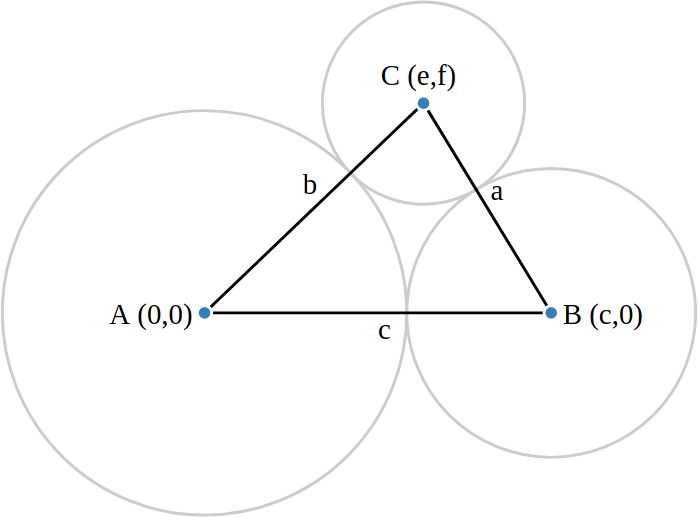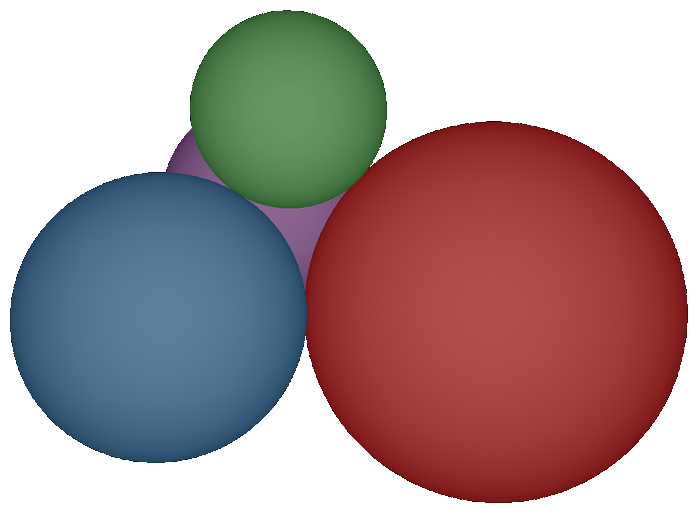
An initial sphere triplet located on the vertices of a triangle with side lengths constructed from sphere radii:

So you want to do some sphere packing to make your inflatable space habitats for deployment on the Moon and Mars snug and cozy. Perfectly straightforward you think to yourself; since one can start with a triplet of spheres tangent pairwise by placing one at some origin on a 2D plane, extending the second out in the 
There's not even time to take a mirco-break to refresh your favourite time sink website before you've busted out the coordinates of

On a roll, you extend the coordinates of 







Pausing for just a moment, you realise you've been on autopilot for a second—since such trivial calculations are self evident. Reflecting on a time that feels so long ago now, when you learnt that a minimal set of four tangent spheres in three dimensions can be described by a tetrahedron. The locus of each sphere's center point is one of the tetrahedron's vertices, and the lengths of each edge of the tetrahedron are defined via the radii of the pair of spheres for which the edge connects their centers. Using the already-known properties of the base triangle; introducing a fourth sphere 

^2+f^2&=a^2,\\&space;\end{aligned})
to the intersection represented by
^2+y_D^2+z_D^2&=n^2\\&space;(x_D-e)^2+(y_D-f)^2+z_D^2&=p^2.\\&space;\end{aligned})
Back from your daydream—that time sink website is calling. Since you've pretty much wrapped this problem up, why not take a peek? After a few sensible chuckles, it dawns on you that there's still work to do. Your sphere packing algorithm is going to feed you positions and radii of arbitrary sets of pairwise tangent triplets for you to calculate the fourth position. This means that if you are solving the tetrahedron in this simple basis, translation and rotation of 
Moreover, this is going to have to happen in a number of steps.
- Remove
's translation component, aligning
to the origin.
- Recalculate
,
,
in the simple basis for this triplet to solve for the fourth locus.
- Denote the solution as
in tetrahedron
, which now must be translated to tetrahedron
's basis to find
.
- Rotate
onto
.
- Rotate
to
by rotating the face normals of the triangle identified in 4 and
.
- Translate this triangle to the
basis by returning the translation component removed in 1.
None of this is too difficult in of its own, but without proper forethought—you're gonna have a bad time.
Basically you're going to end up catching edge cases just to the left of center like a tennis ball to the nuts of a daydreaming ball boy at the US Open.
What happens when you're sent a triplet that has coordinates (in the translated basis) )
)
)




The list goes on, but it suffices to say that you start juggling possibilities like some guy trying to wash a car in an infomercial.
Fret not! There is a better way!
Consider that we have a pairwise tangent triplet with known radii and arbitrary positions in 
Additionally, we know the radius of a fourth sphere we wish to add to the cluster.
To not confuse the skimming reader—I will change notations here, and define a tetrahedron with vertices 






)
The distance values here are straightforward, since they are defined as the sum of the radii along a given edge: 







^2+(y-y_1)^2+(z-z_1)^2&=d_1^2\qquad(1)\\&space;(x-x_2)^2+(y-y_2)^2+(z-z_2)^2&=d_2^2\qquad(2)\\&space;(x-x_3)^2+(y-y_3)^2+(z-z_3)^2&=d_3^2\qquad(3)\\&space;\end{aligned})
Subtract (1) from (2) & (3) to obtain the equations for two planes, and couple this set with (1) to yield the quadratic system:
x+2(y_1-y_2)y+2(z_1-z_2)z&=d_2^2-d_1^2+x_1^2-x_2^2+y_1^2-y_2^2+z_1^2-z_2^2\\&space;2(x_1-x_3)x+2(y_1-y_3)y+2(z_1-z_3)z&=d_3^2-d_1^2+x_1^2-x_3^2+y_1^2-y_3^2+z_1^2-z_3^2\\&space;x^2+y^2+z^2-2&space;x_1&space;x-2&space;y_1&space;y-2&space;z_1&space;z&space;&=&space;d_1^2-x_1^2-y_1^2-z_1^2.\\&space;\end{aligned})
The closed form solution to this system is not the nicest of expressions, so we can consider the equivalent set below in vector format

where )

Notice that 


A solution to 







}{1-(\vec&space;u\cdot\vec&space;v)^2},\quad\beta=\frac{b-a(\vec&space;u\cdot\vec&space;v)}{1-(\vec&space;u\cdot\vec&space;v)^2},)
while the third equation becomes \gamma+d=0)
+\alpha(\vec&space;u\cdot\vec&space;w)+\beta(\vec&space;v\cdot\vec&space;w)-c)
This last equation can finally be solved for 
\pm\sqrt{(\vec&space;w\cdot\vec&space;t)^2-4d}\right).)
With these values you can now solve the irregular tetrahedron in 3D directly! This means no edge cases, no recalculation of previously known values or complex if elseif else blocks based on various input conditions.

The fruits of your labour made manifest.
Congratulations @libbum! You received a personal award!
You can view your badges on your Steem Board and compare to others on the Steem Ranking
Do not miss the last post from @steemitboard:
Vote for @Steemitboard as a witness to get one more award and increased upvotes!
Hi! I am a robot. I just upvoted you! I found similar content that readers might be interested in:
https://axiomatic.neophilus.net/
This is a link to my personal blog, so it's certainly relevant! Thank you helpful robot.
Congratulations @libbum! You received a personal award!
Click here to view your Board